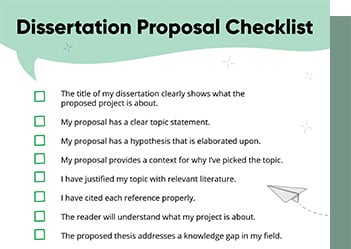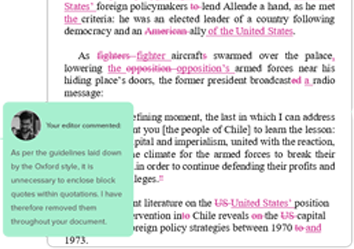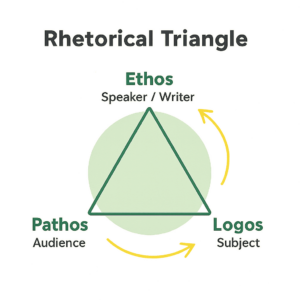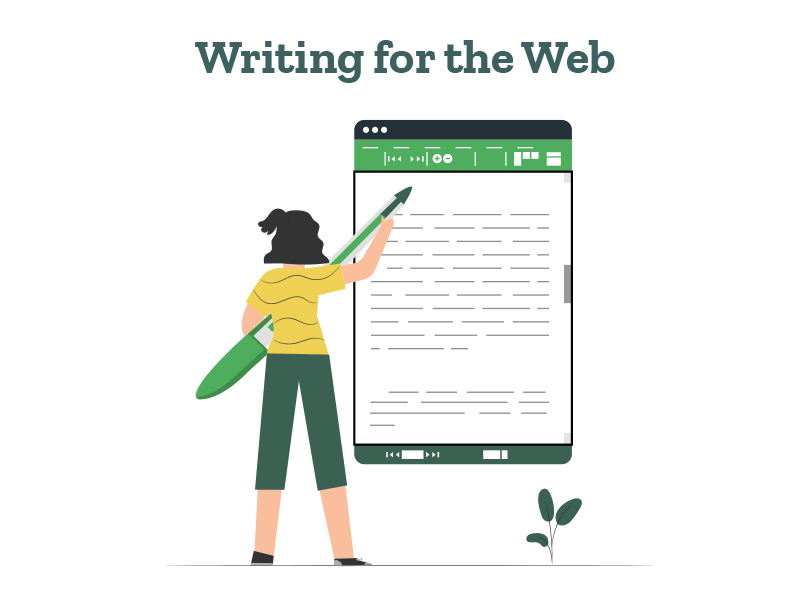Still have questions? Leave a comment

Checklist: Dissertation Proposal
Enter your email id to get the downloadable right in your inbox!
[contact-form-7 id="12425" title="Checklist: Dissertation Proposal"]
Examples: Edited Papers
Enter your email id to get the downloadable right in your inbox!
[contact-form-7 id="12426" title="Examples: Edited Papers"]Need
Editing and
Proofreading Services?

What is Rhetoric and How to Use It in Your Writing
 Jun 08, 2025
Jun 08, 2025 6
min read
6
min read
Rhetoric originated in Ancient Greece 2500 years ago as an essential aspect of public, political, and legal life. The Greek philosopher Aristotle defined rhetoric as ‘the faculty of observing in any given case the available means of persuasion’. According to him, there are three modes of persuasion: ethos (credibility), pathos (emotional appeal), and logos (logical reasoning).
Simply put, the use of rhetoric is necessary to make the best case possible in a debate or when expressing an opinion. According to writer Francis Bacon, ‘the duty and office of rhetoric is to apply reason to imagination for the better moving of the will’. It is therefore necessary to use rhetoric—whether in speech, in writing, or in the visual medium—to get across one’s point in the most effective and convincing manner possible.
Check If Your Use Of Rhetoric And Other Literary Devices Is Correct! Learn More
What is a rhetorical analysis?
A rhetorical analysis is a study of how a point is argued as opposed to what the argument is. In order to use rhetoric effectively, it is important to keep in mind your audience—who are they? How old are they? What is their relationship with you? What are their values and expectations? Answering these questions helps you tailor your use of rhetoric to make the best possible impact, whether in terms of style, genre, word choice, content, and so on.
Canons of rhetoric and the ideas behind them
There exist five canons of classical rhetoric that have been described by the Roman philosopher Cicero and the anonymous author of Rhetorica ad Herennium as follows:
1. Invention
Cicero has described invention as the ‘discovery of valid or seemingly valid arguments to render one’s cause probable’. Today, in order to deliver a credible stance, a great deal of in-depth research and exploration is necessary, rather than simply inventing arguments out of the imagination.
2. Arrangement
Arrangement refers to the structure of a text, comprising various parts that come together to form a compelling piece. In modern day, a text usually comprises the introduction, body, and conclusion. However, in the ancient world, Cicero and the Roman rhetorician Quintilian identified six parts: exordium or introduction, narrative or main argument, partition or division, confirmation or further driving home the point, refutation, and peroration or conclusion.
3. Style
Style refers to the manner in which a particular argument is conveyed. According to Quintilian, there are three levels of style, each of which serves a different purpose: plain style is for instructing an audience, middle style is for moving an audience, and grand style is for pleasing an audience.
4. Memory
This part refers to the methods and literary devices that can be used to improve memory. In Ancient Rome, two distinct kinds of memory were defined: natural or innate memory and artificial or enhanced memory.
5. Delivery
Delivery is the part that ties all the others together. In oral discourse, it refers to voice modulation, expressions, and the use of gestures. It is arguably the most important part of rhetoric—the one that makes the final impact on the audience. In written discourse, it refers to the manner in which all the arguments are shaped and conveyed.
Important aspects of rhetoric
What is kairos in rhetoric?
The exigence or motivating factor behind the employment of rhetoric often dictates how it is used. It is also important to employ the use of kairos, or the ‘right time’ to use a particular form of rhetoric in order to achieve the maximum possible impact. Now that we have covered the basics of rhetoric, let us explore how rhetoric can be used in different media to cater to various exigencies.
What is exigence in rhetoric?
The word ‘exigence’ comes from the Latin word for ‘demand’. It refers to the motivating factor/defect/missing piece that spurs the author or speaker to use rhetoric to address a particular problem. It is essentially the root cause of the usage of rhetoric in any particular instance—it is what the writer or speaker wants to convince the audience of.
What is ethos in rhetoric?
Stemming from the Greek word for ‘character’, ‘ethos’ is the part of rhetoric that appeals to the audience’s belief system and ethics and grounds the speaker’s/author’s credibility.
What is logos in rhetoric?
‘Logos’ refers to logical reasoning, and is that component of rhetoric that is backed up by facts and research, and appeals to the audience’s erudition and reasoning powers to prove a point.
What is pathos in rhetoric?
‘Pathos’ is that component of rhetoric that caters to emotional sensibilities—the use of pathos seeks to prove a point by touching the audience’s heart strings and appealing to their emotions.
Rhetoric in writing
Whether you are writing an essay, a dissertation, a research paper, etc., rhetoric plays an important role in putting across your points effectively. Such works often center around an argument that needs to be backed up with sources and proven to be credible. In addition to providing strong sources from existing research, it is also helpful to use well-placed rhetoric to drive one’s point home. Some examples are alliteration (consecutive words starting with the same letter), metaphor (comparing a thing or idea to something else that shares similar qualities), anaphora (the recurrence of a phrase or word at the beginning of successive sentences for added emphasis), hyperbole (exaggerating something to make it sound more interesting or exciting), etc.
Rhetoric in literature
Several writers have employed the use of rhetoric in their writings to make them impactful and memorable. The use of rhetoric in literature elevates otherwise commonplace-sounding lines and etches them in the reader’s memory as something worth quoting. A famous example of the use of rhetoric in literature occurs in Shakespeare’s Merchant of Venice, where the character of Shylock poses a powerful rhetorical question to describe his dehumanisation: “I am a Jew. Hath not a Jew eyes?”
Rhetoric in speech
Rhetoric is a powerful tool used by orators and politicians to put across their points effectively and strike a chord with their audience. Some examples of rhetoric in speech are satire, asking rhetorical questions, using alliteration, and using metaphors and chiasmus (reversing the order of sentences to make an impact). An example of the use of rhetoric, specifically chiasmus, can be seen in John F. Kennedy’s 1961 inaugural speech: “Ask not what your country can do for you, but what you can do for your country.”
You can find the speech here: President John F. Kennedy’s Inaugural Address | January 20, 1961
The speaker often employs pathos to appeal to the audience’s emotions. Famous speeches that are rich in the use of rhetoric are Martin Luther King Jr’s ‘I Have a Dream’ and Abraham Lincoln’s Gettysburg Address.
Visual rhetoric
Visual rhetoric can be defined as the use of images, typography, texts, and other visual elements that help a viewer analyse and understand an argument better. It is particularly useful in cyberspace, involving the use of colors, graphs, fonts, and the manner in which text is arranged on a particular page. A good example of visual rhetoric is the use of GIFs to convey a reaction or to add a humorous touch to a situation.
The appeal of rhetoric lies in the fact that it comes naturally to most human beings and can be easily used across a variety of media. It is one of the most widely used tools by politicians, orators, writers, and students alike, and it is often up for public analysis and deconstruction to get to the root of the argument. Rhetoric is an important tool employed in the process of writing as well, and adds value and quality to your work.
Check out PaperTrue’s expert editing and proofreading services and writer support to enhance your writing today! With our expert editors, detailed instructional blogs, and AI-powered services, we can give your writing the care and attention it deserves and help you achieve your true potential!
Here are some more resources that may help you:








